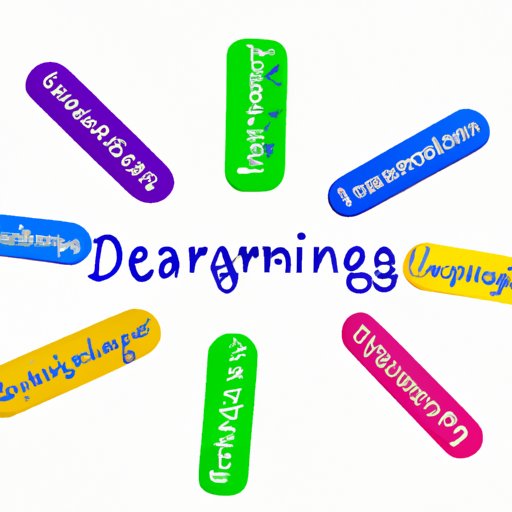
I. Introduction
Learning disabilities (LD) refer to neurological disorders that impair one’s ability to process, store, and communicate information efficiently. These disabilities impact a person’s academic, social, and occupational performance, and can make simple tasks like reading, writing, and math challenging.
As per the National Center for Learning Disabilities, 1 in 5 children in the United States have learning disabilities, yet only 17% receive specific LD services. This symposium aims to create an easy-to-understand learning disability guide that explains the types, symptoms, causes, and proven strategies for parents, caregivers, educators, and people with LD to overcome them and achieve their goals.
II. Understanding Learning Disabilities: Types, Symptoms, and Causes
A. Definition of learning disabilities: Learning disabilities are a category of neurodevelopmental disorders that affect the brain’s ability to store, process, and communicate information. These disorders may prevent people from learning efficiently or developing essential academic/social skills to fulfill their potential.
B. Types of learning disabilities: The most common types of learning disabilities include dyslexia, dysgraphia, dyscalculia, auditory processing disorder (APD), and visual processing disorder (VPD).
C. Common symptoms of learning disabilities: Symptoms of LD vary depending on the person and their type of disability. Some common symptoms include difficulty with reading, writing, math, identifying letters or numbers, and difficulty following instructions. Individuals may also face issues with memory, organization, social interaction, and motor coordination.
D. Causes of learning disabilities: Learning disabilities can be caused by various factors, including genetics, brain development issues during pregnancy or birth, brain trauma, environmental factors, or general developmental conditions.
III. Empowering Children with Learning Disabilities: Strategies for Parents and Teachers
A. Understanding the needs of children with learning disabilities: Parents, caregivers, and educators must understand the unique needs and challenges of children with LD. This understanding can help build trust, nurture their potential and keep them motivated as they navigate their LD journey.
B. Identifying and addressing learning disabilities: Early identification, proper diagnosis, and appropriate interventions are crucial in managing learning disabilities. Parents, caregivers, educators, and health practitioners need to be proactive in identifying LD symptoms, getting them evaluated, and pursuing effective interventions.
C. Techniques for parents and teachers to support learners with learning disabilities: Tailor-made teaching techniques such as multi-sensory learning, repetition, task break-down, positive reinforcement, and assistive technology can help learners with LD better process information, reduce anxiety/boredom while learning.
D. Collaborative approaches to support learning: Building a supportive learning environment with clear expectations, open communication with the educational team, and partnership with schools, local organizations and MHPs can help individuals with LD feel included, valued, and celebrated.
IV. Breaking the Stigma: Dispelling Myths About Learning Disabilities
A. Common myths and misconceptions about learning disabilities: There are numerous myths and misconceptions about learning disabilities, such as “individuals with LD are intellectually disabled” or “LD can be outgrown with age”. These myths can be harmful, cause embarrassment and stigma, and lead to misdiagnosis and suboptimal treatment.
B. Addressing stigma towards learning disabilities: Addressing this stigma requires education, awareness, and advocacy. It entails debunking myths, celebrating differences, and building an inclusive society free of bullying, discrimination, and bias.
C. Raising awareness and promoting acceptance of learning disabilities: It is essential to foster positive attitudes towards LD. By promoting accessible environments, community programs, and support groups, we can promote awareness, tolerance, and empowerment among people with LD and their families.
V. Navigating Life with a Learning Disability: Real Stories of Triumph and Resilience
A. Personal experiences of individuals with learning disabilities: People with LD may experience a range of challenges when it comes to learning, employment, and social interactions. However, some individuals demonstrate incredible resilience, persistence, and creativity in overcoming these challenges, pursuing their goals and finding enjoyment in life.
B. Challenges faced by individuals with learning disabilities in various contexts: Individuals with LD may experience difficulties in different contexts such as academic life, social life, employment, and mental health. These challenges may result from gaps in policy, lack of accommodations, and discrimination.
C. Strategies for coping and thriving with learning disabilities: Some proven strategies that can help individuals with LD develop the necessary skills to cope with their disability and achieve their goals include building their strengths, seeking supportive communities, using assistive technology, and developing positive coping mechanisms.
VI. The Science Behind Learning Disabilities: Current Research and Future Directions
A. Overview of current scientific understanding of learning disabilities: Researchers are continually exploring ways they can better understand the mechanisms behind learning disabilities, how they manifest, and how they can be treated. Current scientific research shows that learning disabilities are a neurological issue, can be further subdivided, and have various degrees of occurrence.
B. Promising areas of research for improving outcomes for individuals with learning disabilities: Experts are exploring cutting-edge approaches like brain imaging, genetic studies, and early intervention programs to help individuals with LD efficiently develop the skills necessary for a better life. Additionally, they are working on intervention programs aimed at improving various aspects of cognitive functioning.
C. Implications for the future of education and policy: The understanding of learning disabilities and emerging research trends implies that policymakers should evaluate long-term resources to sustain successful intervention programs in schools and communities and promote public awareness of learning disabilities.
VII. Conclusion
A. Recap of key points from the article: This article presents a comprehensive guide to understanding learning disabilities, the challenges individuals face and potential solutions to overcome those challenges.
B. Importance of addressing learning disabilities for individuals and society at large: Addressing learning disabilities is crucial for enabling individuals to overcome difficulties and lead fulfilling lives. This includes improving their educational, social, and economic outlook, promoting mental health and overall quality of life.
C. Final thoughts and call to action: We need to shift focus from the problems of LD to the potential solutions. By promoting inclusiveness, celebrating diversity, and providing proper support and resources, we can empower people with learning disabilities to thrive in their personal and professional lives.




